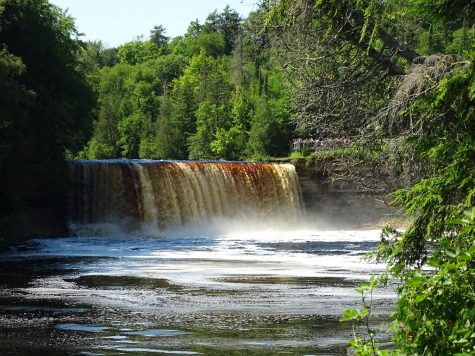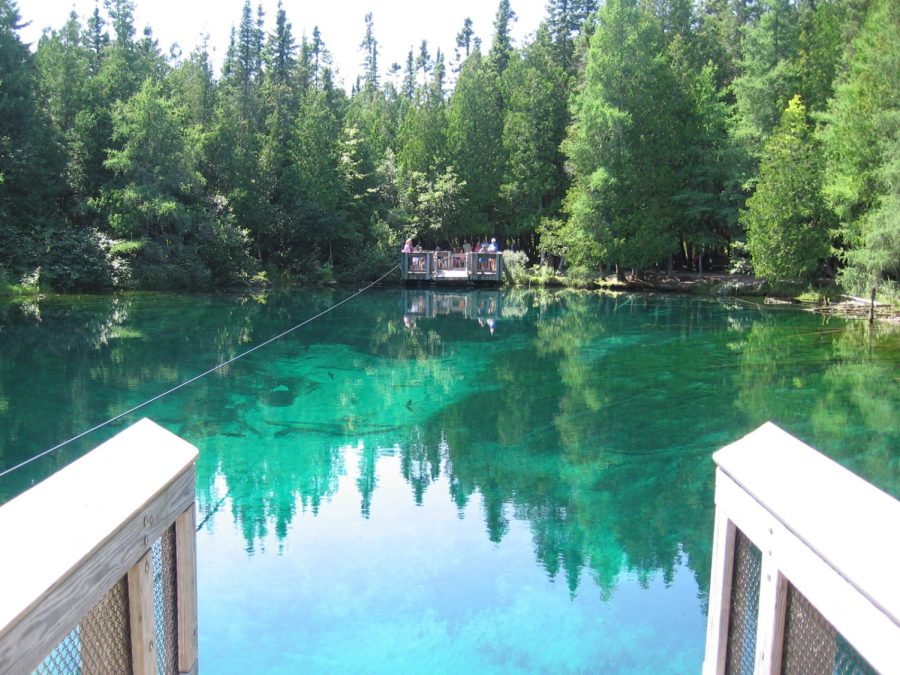Unknown gems: Great places to visit in the Upper Peninsula
A view of the spectacular waters of Kitch-iti-kipi from the observation raft.
March 14, 2023
Yellowstone. The Grand Canyon. The Arches. The United States contains some of the most astonishing places on earth. With amazing national parks across the country, the places close by often go unnoticed. These under-the-radar locations in Michigan make journeying far from home unnecessary.
Kitch-iti-kipi
Meaning “the big spring” in Ojibwe, Kitch-iti-kipi holds the title of the largest freshwater spring in Michigan. Only two hours west of the Mackinac Bridge, a short drive provides access to one of the many gems of the Upper Peninsula.
Hidden in Palms Book State Park, the big spring spans 200 feet across and 40 feet in depth. The frigid crystal clear water gushes from a fissure in the limestone below at over 10,000 gallons per minute, maintaining a constant temperature of 45 degrees Fahrenheit.
The observation raft delivers the view visitors come for. Preserved by the cold temperature of the water, the submerged ancient tree trunks resemble a prehistoric landscape. The frigid water also hosts countless plump trout suspended, waiting for their next meal.
“It’s a gem–amazing to be able to see down in the clear water and see the fish deep below. It’s like being next to a giant aquarium,” Instructor Doug Mandrick said. The depths of the big spring give a picturesque scene found nowhere else in the state and match those around the country.
Porcupine Mountains Wilderness State Park
Located near the western tip of the Upper Peninsula, the Porcupine Mountains features vast landscapes. The rolling old-growth forests, cascading waterfalls, rocky Lake Superior shoreline, and towering mountains attract outdoor enthusiasts and people looking to pause their busy life. Instructor Dan Blake described the park as a “pure natural environment. Not a lot of people around. Pretty rustic. A chance to experience wilderness.” The Lake of the Clouds and the Presque Isle River corridor give alluring views of untouched bodies of water.
The Porcupine Mountains have a plethora of activities to help visitors experience the breathtaking views of the park. In the warmer months, visitors may go swimming, hiking, fishing, biking, and camping. In the winter, snowshoeing, cross-country skiing, and snowmobiling entertain guests willing to brave the cold. The state park even has a downhill ski mountain. The runs exceed a mile long and total nearly 700 vertical feet. Although the untamed terrain of the Porcupine Mountains Wilderness State Park attracts visitors, the activities keep people returning.
Tahquamenon Falls State Park

For those seeking a secluded area, Tahquamenon State Park certainly provides exactly that. Only one hour from the Mackinac Bridge, the park consists of undeveloped forests, lacking roads, buildings, and power lines in the majority of the park.
As the crown jewels of the park, the dazzling waterfalls enthrall viewers. The Upper Tahquamenon Falls holds the title of the largest waterfall in Michigan, plunging 50 vertical feet and spanning 200 feet. The Upper Falls captivates guests, astounded by the sheer force of the water. “The water falls off the worn rocks so very elegantly, the water is brown but is still a joy to look at,” Jr. Carson Dobb said.
Four miles downstream, the Lower Falls consist of five smaller falls flowing around an island. Visitors can access the island as a viewpoint for the Lower Falls by bridge or rowboat. The coffee color of the water intrigues onlookers, another characteristic unique to the falls.
Hiawatha National Forest
The National Forest has an East Unit and a West Unit, totaling 879,000 acres and six distinct wilderness areas. Known as “the Great Lakes National Forest,” the park has 100 miles of beautiful shoreline on three of the five Great Lakes. The soaring cliffs and sandy beaches host six historic lighthouses within the park boundaries, allowing guests to discover the unique maritime history of Hiawatha. Scenic roads winding through the park highlight the brilliant colors during the fall season.
Hiawatha National Forest also contains five rivers, supplying pristine fishing holes for anglers and raging rapids for canoes. The hundreds of miles of trails in Hiawatha provide some of the best hiking, biking, and cross-country skiing in all of Michigan.
Instructor Andy Hamilton experienced the wonders of Hiawatha through his time at the Clear Lake Education Center. “At night, the lake would come alive with the sound of barred owls, who sound very much like howler monkeys. That was a new experience for me and I haven’t really heard that anywhere since,” Hamilton said.
Located on the shore of Lake Superior in the East Unit of the park, Grand Island National Recreation Area allows visitors to learn more about the cultural history of the area. The island also has campsites and outstanding views of the beaches and cliffs surrounded by Lake Superior. The diverse region makes Hiawatha National Forest such a special location.
Parks and locations like these make Michigan so amazing. The remote spots scattered throughout the Upper Peninsula avoid the spotlight, but for those lucky enough to have experienced them, they find excuses to keep coming back.





